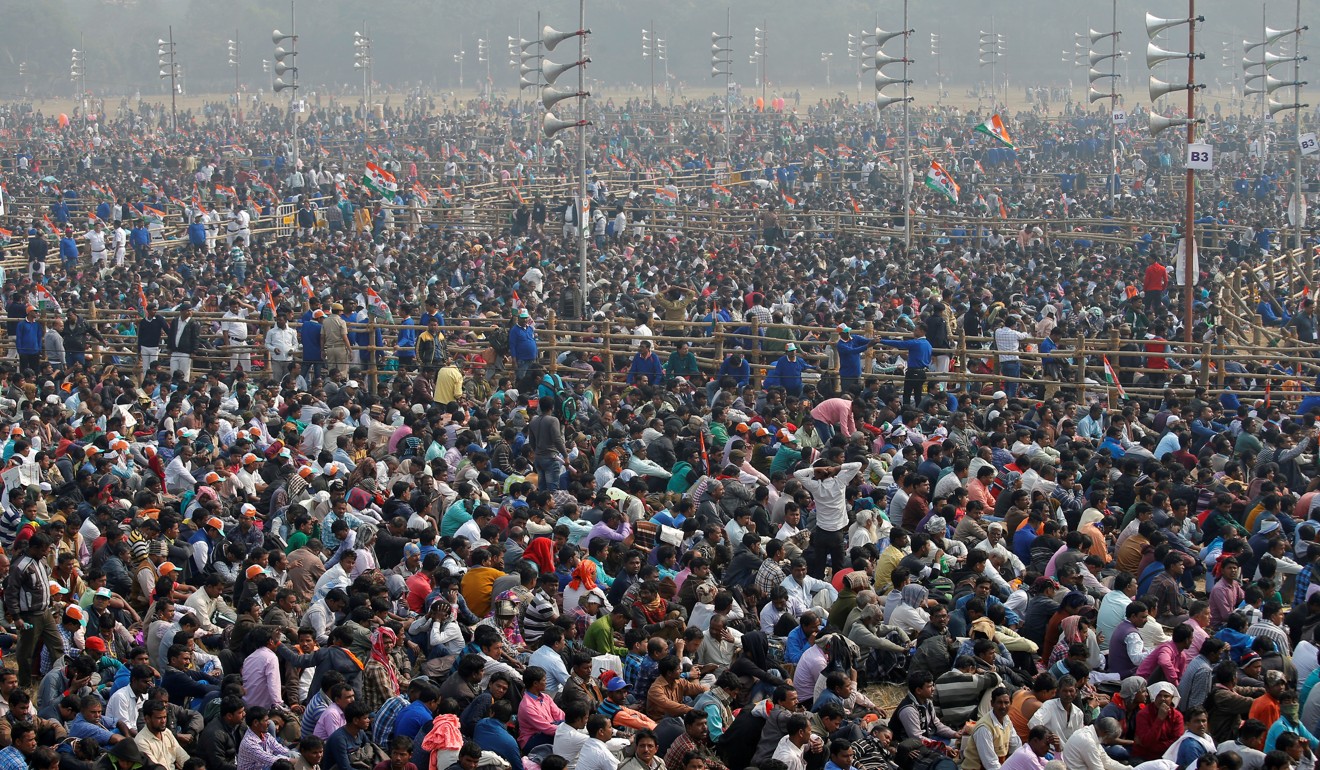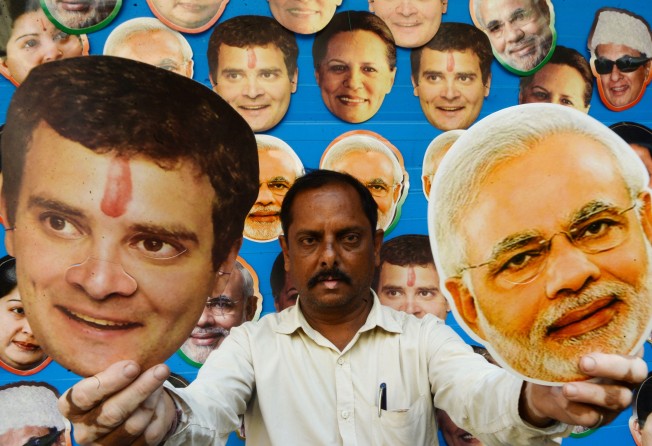
Gandhi to cow vigilantes, fake news and ‘watchman’ Modi: India’s election explained
- Prime Minister Narendra Modi is promising voters he’s India’s ‘watchman’
- Religious violence, unemployment, demonetisation, fake news and big-name opposition are some of the things he should have seen coming

As Indian Prime Minister Narendra Modi seeks another five-year term, he has promised to stamp out corruption and other social ills, telling the country: “I am your watchman” (Main bhi chowkidar).
He has even added the Chowkidar prefix to his Twitter handle, as have other ministers, while the campaign slogan features in songs, films and T-shirts.
The slogan is a response to criticism from the opposition Congress party, whose leader Rahul Gandhi coined the phrase “The watchman is a thief” (Chowkidar chor hai), criticising Modi over an alleged scam involving Rafale fighter jets produced by French firm Dassault.
More Indians are expected to vote this year than ever before but it remains to be seen whether Modi’s combative tone helps his Hindu nationalist Bharatiya Janata Party (BJP) repeat their landslide victory of 2014.
HOW IT WORKS
Voting will take place between April 11 and May 19, with votes counted on May 23. Of the 900 million voters, about 10 per cent or 85 million will be casting ballots for the first time, requiring 10 million election officials to staff 1 million polling stations.
For the first time, the faces of the candidates along with their party symbols will be displayed on electronic voting machines, to prevent confusion in a country with 287 million illiterate adults.
India’s lower house of parliament, or Lok Sabha, has 543 elected seats. To form government, any party or coalition needs at least 272 seats. The prime minister is appointed by the president based on the composition of the Lok Sabha.

Uttar Pradesh, India’s most populous state with 200 million people, is a crucial battleground, as it has the largest parliamentary representation, with 80 seats. Other important states include Maharashtra (48 seats), West Bengal (42), Bihar (40) and Tamil Nadu (39).
WHO CAN CHALLENGE MODI?
Modi’s BJP won 282 seats in the 2014 general election, and commanded a record total of 336 seats through its partners in the National Democratic Alliance. However, Modi’s popularity has been diminished by sluggish economic growth, rural discontent over flagging agricultural prices and a shortage of jobs, although the recent showdown with neighbouring Pakistan brought a timely boost.
Modi can draw further confidence from the disjointed state of the main national opposition party, the Indian National Congress, which has dominated much of India’s post-independence politics. It is led by Rahul Gandhi, the scion of India’s powerful political dynasty, the Nehru-Gandhi family. Gandhi is the son, grandson and great-grandson of former prime ministers.
Congress suffered its worst defeat in the 2014 election, securing only 44 seats – down from 206 seats – and winning less than 20 per cent of the popular vote. However, in December 2018, Congress ousted the BJP in three key states – Chhattisgarh, Madhya Pradesh and Rajasthan – two of which the party had controlled for 15 years – inflicting Modi’s biggest setback at state level since he became prime minister. Congress has pursued alliances with regional parties as it fights to remain relevant.
CAN MODI RUN ON HIS RECORD?
India’s economic growth is well-documented. In just over a decade, poverty has nearly halved, falling from roughly 55 per cent in 2005 to about 28 per cent in 2016. In that time, 271 million people have been elevated out of poverty, according to the United Nations Development Programme (UNDP) and the Oxford Poverty and Human Development Initiative (OPHI).
Nearly two-thirds of the country’s 1.3 billion people are 35 or younger and Modi promised to usher in acche din (“good times”) for the economy. However, a leaked report in January showed India’s unemployment hit a 45-year high in 2017.
Furthermore, two of Modi’s signature reforms delivered shocks to the economy, hurting small businesses in particular and resulting in millions of jobs lost.

In November 2016, Modi sought to tackle the problem of “black money” – undeclared, untaxed and illegal money in the economy – by cancelling the country’s largest banknotes, the 1,000 rupee (about US$15) and 500 rupee bills, accounting for 86 per cent of India’s currency. Modi’s demonetisation caused major disruption in India’s cash-dependent economy and its execution was widely criticised.
In July 2017, Modi implemented a national goods and services tax (GST), designed to establish a single market across the country. The chaotic roll-out hurt Indian exporters and Gandhi vowed to introduce a simpler one-rate tax system with “GST 2.0”.
Modi’s rise to power has also coincided with increased sectarian violence and attacks on religious minorities – Muslims, Christians and Dalits – carried out by radical Hindu “cow vigilantes” who attack people accused of slaughtering cows, which are deemed sacred. Hindus make up roughly 80 per cent of the Indian population, and the BJP has been accused of emboldening hardliners.
Escalating tensions with Pakistan have also cast a long shadow over the campaign. Modi launched air strikes targeting an alleged terrorist training camp in Pakistan after a suicide bomb in Indian-administered Kashmir killed at least 40 paramilitary officers on February 14.
FAKE NEWS
India has more new internet users than anywhere in the world. Over the next three years, according to industry projections, the number of Indians online will increase by more than 58 per cent, to 762 million. Most of the growth will come on smartphones hooked up to data connections – and two out of three smartphones in India use WhatsApp.
It has also created an atmosphere in which misinformation or “fake news” can spread rapidly with dire consequences.
Last year, at least 30 people were lynched after false stories about supposed kidnappings circulated through WhatsApp. In response, WhatsApp capped chat groups at 256 members and imposed a five-recipient message forwarding limit.
Traditional media remains the primary source of information for Indians but doctored newspaper clippings and manipulated television-news screenshots proliferate on social media.
During the campaign, Facebook said it removed “inauthentic” accounts and pages, including those linked to the BJP and Congress. Both Twitter and Facebook promised greater transparency by revealing spending by political parties.